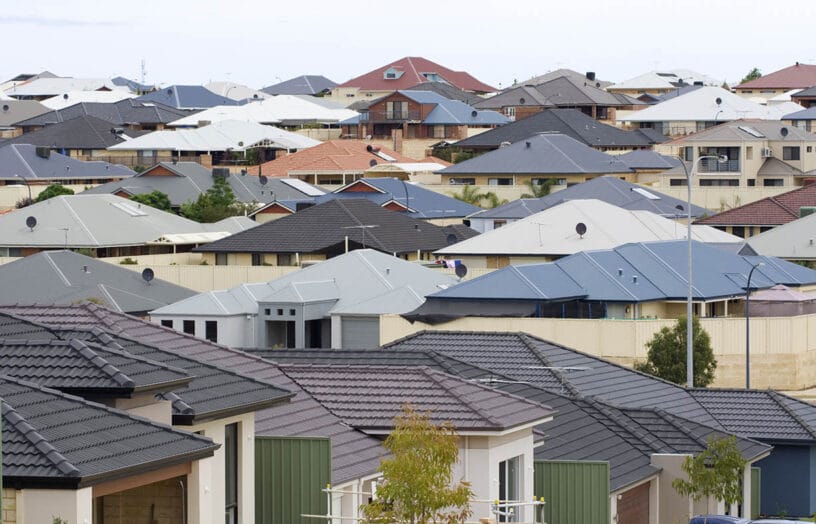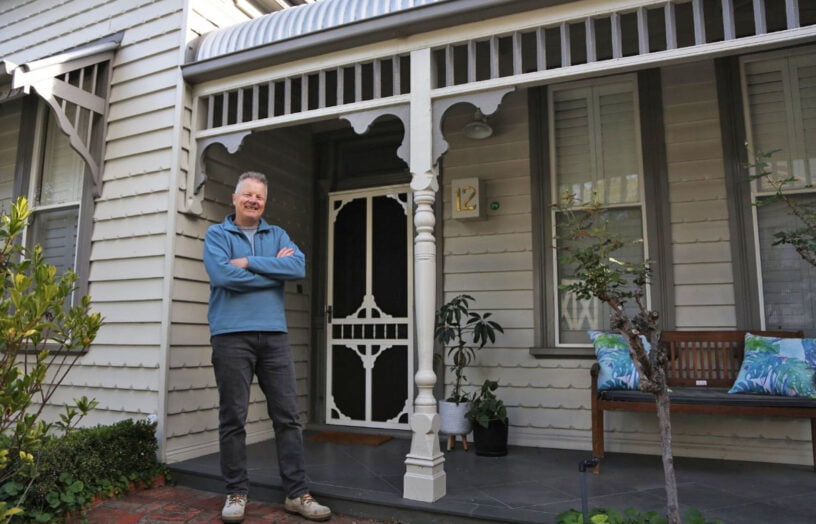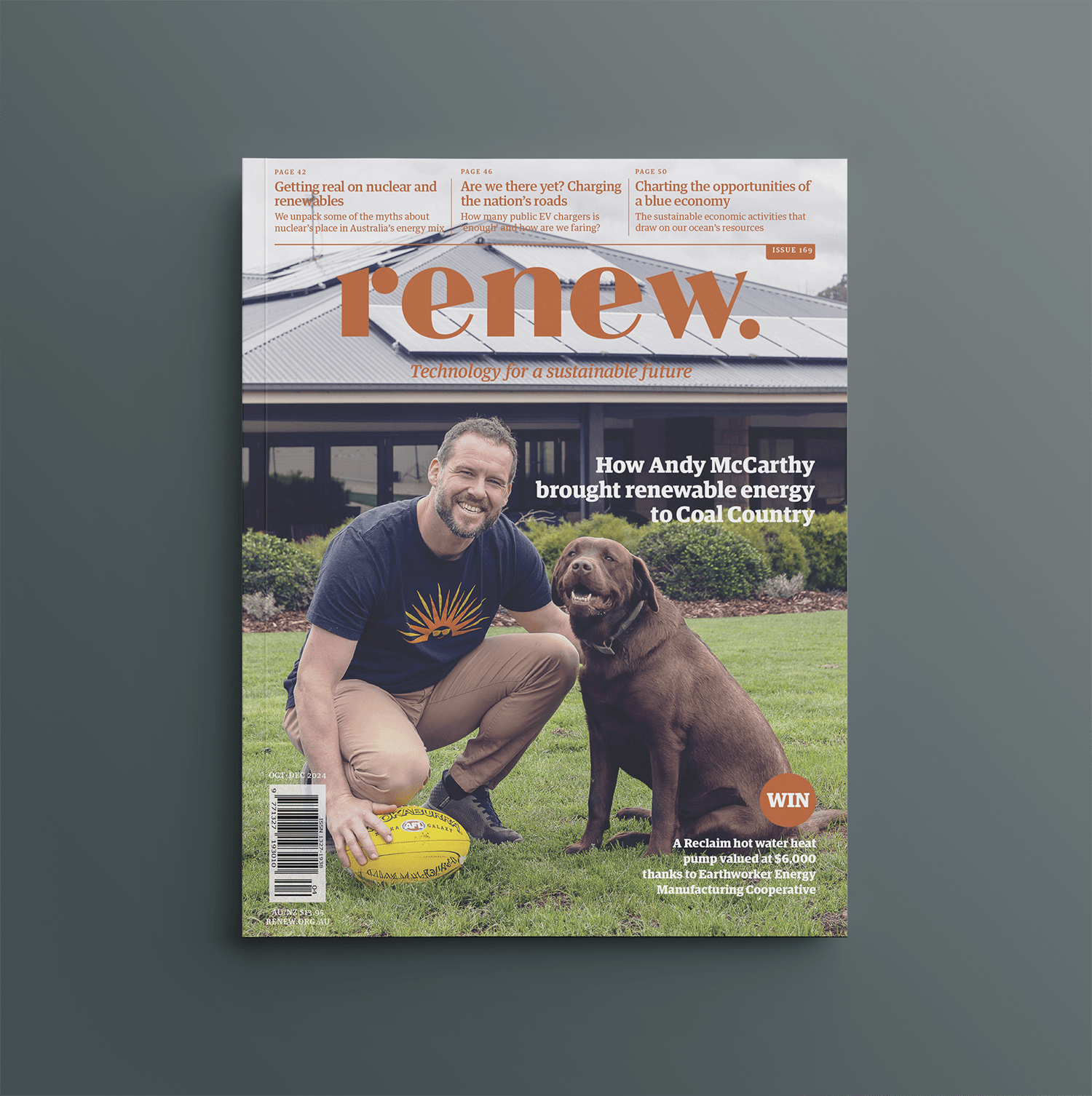Capital improvements: The path to all-electric

Switching to electric appliances wasn’t really thought of as economically or environmentally beneficial 10 years ago when Ben Elliston’s household started their efficiency improvements, so theirs has been a gradual path to all-electric.
This article was first published in Issue 140 (July-Sept 2017) of Renew magazine.
You could call Ben Elliston’s household a ‘poster child’ for getting off gas, but that’s not how it began. Rather, when they started the process to improve the efficiency of their Canberra home 10 years ago, the family’s mindset was aligned with the message at that time that gas was a cheaper and relatively clean fuel, compared to grid electricity. Ten years on and several ‘face-palm-why-did-we-do-that’ moments later, they are now enthusiastically all-electric, with their energy use, operating costs and greenhouse gas emissions all pleasingly reduced—and with some added advantages of their new electric appliances that they didn’t expect.
Looking back, Ben says one of the biggest shifts has been in what a state-of-the-art electric appliance looks like. From the simple electric element appliances of the 80s (the coil cooktop, electric blow heaters and electric element tanks), many of the newer appliances offer not only lower running costs—over both gas and older electric units—but also safety and other benefits. Ben says, “There were lots of advantages we hadn’t anticipated when we shifted to electric appliances. For example, our induction cooktop has smarts to switch off if it senses that a pot is too hot and has run dry; our heat pump air conditioner is also much quieter than our old gas wall heater.”
The other major factor for Ben’s family is environmental. With the ACT now well on the way to 100% renewable electricity by 2020, Ben says, “In 2020, our household will be net zero emissions, which would not be possible if we were still using any gas appliances.”
The benefit of hindsight
However, travelling back to 2006/07, the landscape was still one where gas was preferred. So they began improvements on their new home with two “face-palm moments”—two decisions which they later came to see as “big mistakes”. Firstly, they plumbed their barbecue to natural gas: great for convenience and lower cost, but not so great when they decided to quit the gas network. However, this was relatively easy to undo in 2017, when they converted the barbecue back to bottled gas.
The other “mistake” proved more problematic. In 2007, Ben was keen to install solar thermal hot water, and best practice at that time suggested gas-boosted solar. Unfortunately, the tank in this system didn’t include an electric element, so they couldn’t easily switch to electric boosting. Not wanting to throw away their investment in a solar thermal system, it took some time and a bit of luck to get the system off gas. The luck came in early 2017 in the form of an electric tank on Gumtree, compatible with their system and which they were able to buy and plumb in for $700 (with free delivery from Sydney in the back of a friend’s car!).
Decision to go all-electric
The household’s impetus to switch to all-electric only really began in 2013, tapping into discussions online about the environmental and financial benefits, combined with advocacy by Beyond Zero Emissions in their Buildings Plan (2013), the ATA’s report ‘Are We Still Cooking With Gas’ (2014) and Richard Keech’s Energy-Freedom Home (2015). Dave Southgate’s online publications laying out his family’s steps to become fossil-fuel-free provided more inspiration.
Ben and his family decided to tackle their house’s conversion as a long-term project, not wanting to discard working appliances without being sure of the benefits.
Heater changes first
So, in 2013, they began by replacing one of two gas heaters—the gas wall heater in their living room, which was on the verge of needing major repairs—with a floor-mounted Daikin reverse-cycle unit. Though choosing the floor-mounted unit meant a “performance penalty” over some of the higher COP wall-mounted units, they’ve been happy with their choice from a comfort point of view. “It blows heat at floor level, which means we don’t have warm air blowing over our faces,” says Ben.

Having previously (over 2008 to 2012) improved the insulation in their passive solar house, retrofitted double glazing and added curtains and honeycomb blinds on all windows, the heater has performed really well for them.
“In winter, we have it come on automatically a couple of hours before we get up and for a few hours after dinner, so maybe an average of five hours a day. We don’t need to use it during the day on sunny winter days, only on days that are heavily overcast.” On the day I talk to Ben, it’s a sunny but chilly 14 °C May day in Canberra, and inside it’s 21 °C without the heater on.
Following that successful heater switch, in 2014 they went ahead with a similar replacement of the gas log fire in their lounge room. They rarely use this second heater, and the bedrooms and hallway aren’t heated at all. “Our approach is to heat living areas and rely on insulation elsewhere, so the bedrooms are just slightly chilly, but not iceboxes,” says Ben.
Advice Ben would give when choosing a heating system is to ensure the thermal power matches what you had before (assuming that was providing a comfortable level of heat). And, of course, insulate first. He is also not a fan of central heating—“in Canberra, it’s two to three times more expensive to run.”
Induction reservations overcome
Their next step in January 2016 was one they’d had reservations about—replacing their gas cooktop with an induction unit. For them, and perhaps for many others Ben thinks, cooking was one of the biggest barriers to getting off gas. But their concerns proved unwarranted and, in fact, they’ve found many benefits in the switch.
The timing was dictated by an “excellent sale” on induction cooktops. They also did their research first. “We visited a local appliance retailer to see a cooking demonstration and that helped answer a lot of our initial concerns; I’d recommend that as a way to learn more about induction,” says Ben. They really like how much easier the cooktop is to clean, its safety features and that it generates much less heat from cooking. Ben thinks the latter could have a big impact if induction cooktops are adopted in commercial kitchens; “I understand that a large part of the cooling load for restaurants comes from the kitchen.”
Done and disconnected
With the induction cooktop in place, they completed their transition to all-electric in January 2017, reverting to bottled gas for their barbecue in December 2016 and switching the tank on their hot water system in January. Disconnecting was straightforward and “didn’t even require a phone call”—they simply closed their gas account using an online form on the retailer’s website. They’re planning to get a plumber out to cap the meter on the customer-side of the supply line (which Ben understands the household has control over) to avoid any concerns re gas leaks.
Costs and savings
All up, it has cost them about $10,000 for appliances and installation over 10 years, excluding their purchase of solar PV (2 kW in 2008 and 4.3 kW in 2013—the latter was “twice as large for half the cost,” says Ben!) and an electric vehicle (EV) in 2016.

Total energy usage (gas, electricity and petrol) has plummeted to almost a quarter (see Figure 1). Electricity use has risen, of course, but not by as much as you might expect; in 2008 before any of the changes, they used around 620 kWh in the summer quarter (7 kWh/day) and 850–1150 kWh in winter (9.5–12.5 kWh/day); in 2016, before purchase of an EV, the summer figures had barely changed, but winter usage had increased to around 1200–1450 kWh (13–16 kWh/day). This is before the change to electric boosting for the solar hot water system, so it will be interesting to see how that affects usage this winter.
With the purchase of an EV in late 2016, electricity use also went up by around another 600 kWh per quarter, or 6.5 kWh/day (dependent on how much they use the EV).
The electricity bill for last year’s winter quarter was about $300 before any solar PV credits. This bill covers their winter heating with two electric heat pumps, and all electric appliances except for hot water and EV; less than many household’s bills just for gas heating, this is “not bad at all!” as Ben says. (Note that they are on a gross meter so usage and PV generation are kept separate on their bill, without on-site use of PV. Note also the lower electricity tariff of 18.2c/kWh which applies in Canberra!)
The family’s aims have been met and all they need to do now is sit back and enjoy the lower running costs, lower emissions and improved features of their new state-of-the-art appliances. With their EV and solar PV driving the household’s greenhouse gas emissions down even further, here’s hoping theirs is a path that will be followed by other homes in Canberra and around Australia.
All-electric home features
- Two Daikin FVXS60LVMA floor console split systems (7 kW heating, COP 3.45)
- Ceiling fans in living areas and bedrooms.
- Endless Solar solar hot water system (30 tubes, 315 L electric-boosted tank).
- Bosch electric oven and microwave
- Electrolux EHI935BA induction cooktop.
- Excellent solar orientation (15 degrees west of north); living areas on north, sleeping areas and bathroom on south
- Insulation: ceiling—fibreglass R5; walls—Bradford SoundScreen R2.5 in most external wall areas
- Concrete slab with no insulation
- Double glazing on all windows: aluminium/timber composite windows; low-e double glazing units filled with argon; no tint—maximum solar gain for Canberra
- Draught sealing applied
- Heavy curtains on most windows. Honeycomb blinds used on some narrow windows where curtains wouldn’t work
- Mostly LED lighting (replacing CFLs with LEDs as they fail).
This article was first published in Issue 140 (July-Sept 2017) of Renew magazine. Issue 140 is our all-electric special, including how-tos, economic analysis and case studies.
Recent articles
 All-electric
All-electric
Mandatory disclosure of energy ratings on the horizon
Graham Hunt introduces us to a soon-to-be-implemented national framework that will be a massive win for renters and homebuyers.
Read more All-electric
All-electric
A gas-to-all-electric and EV retrospective in data
Peter Hormann's household has invested in energy efficiency and converted from gas-electric to all-electric for their 1908 Edwardian home in Melbourne. So what can be learnt from the last 8 years through data? What might have happened otherwise?
Read more Efficient homes
Efficient homes
Building for a changing climate
Are we building homes for the future, or for the past? Rob McLeod investigates how climate change is impacting home energy ratings and the way we build our homes.
Read more
